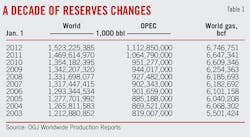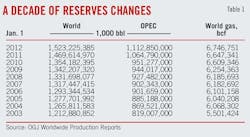Oil and Gas Journal's annual look at reported worldwide oil reserves shows an increase to 1.52 trillion bbl from 1.47 trillion in last year's survey (OGJ, Dec. 6, 2010, p. 46). The bump in oil reserves is largely due to additions in the Middle East. Natural gas reserves total 6.7 quadrillion cu ft, up 1.5% from those reported a year ago.
OGJ collects estimates of proved reserves from an annual survey of official sources, including government agencies and ministries. Since most countries do not assess their reserves annually, many of the figures in this report are unchanged from a year ago.
Reserves changes
Petroleos Mexicanos (Pemex) reported that as of Jan. 1, Mexico's estimated proved oil reserves totaled 10,161 million bbl, 60% of which is heavy crude, 29% is light crude, and the remaining 11% is extra-light crude. Offshore oil accounts for 69% of the reserves.
Mexico's proved gas reserves total 17,316 bcf, 62% of which is associated gas and 43% is offshore. At 11.966 tcf, the 2010 gas reserve figure that OGJ reported represented dry gas only, while the newest estimate is total gas. Pemex reports that as of Jan. 1, 2010, its total gas reserves were 16.8 tcf.
For some countries, including Australia and Thailand, reported oil reserves figures include large volumes of condensate. Australia's commercial proved and probable condensate reserves total 657.76 million bbl. And Thailand's Department of Mineral Fuels reported reserves of 197 million bbl of crude and 245 million bbl of condensate as of Dec. 31, 2010, vs. a year-earlier combined 435 million bbl of crude and condensate.
In the previous edition of this report, Australia's reserves also were reported using McKelvy classification estimates. This year OGJ obtained the country's traditional industry classification estimates from Geoscience Australia (GA), which reported proved and probable commercial oil reserves in Australia at 767.9 million bbl.
GA also reported that Australia's recoverable crude oil reserves have not yet been declared commercially viable and which may be either geologically proved or are awaiting further appraisal are estimated to be 585 million bbl. Such condensate reserves total 2,075 million bbl.
Proved gas reserves for Mozambique are unchanged from a year ago at 4.5 tcf, although Eni SPA estimates the potential of its offshore Mamba South-1 discovery is 7.5 tcf of gas in place. Eni reported that this discovery can lead to a potential of up to 22.5 tcf of gas in place in the area (OGJ Online, Oct. 27, 2011).
OPEC reserves
Most of the reserves figures reported here for members of the Organization of Petroleum Exporting Countries are referenced from the organization's most recent annual statistical bulletin.
Total oil reserves for OPEC are up almost 5% from a year ago, and gas reserves are up nearly 4% from those figures that OGJ reported last year.
Increases include an 11% climb in Ecuador's reported oil reserves to 7.21 billion bbl and a 24% increase in Iraq's oil reserves to 143.1 billion bbl.
Reported gas reserves climbed by 12% in Iran to 1,168 tcf and declined in Libya by 3% to 52.8 tcf.
OGJ has not changed Venezuela's oil reserves from 211.17 billion bbl, although OPEC's annual review now reports that the country's oil reserves total 296.5 billion bbl. This figure would put the South American producer's reserves above those of Saudi Arabia, where oil reserves are now reported to total 264.52 billion bbl.
OPEC's oil reserves total 1,112.85 trillion bbl, or 73% of the worldwide total. And at 3,330.1 tcf, OPEC's gas reserves account for 49% of the world's gas reserves.
Displaying 1/2 Page1, 2Next>
View Article as Single page


